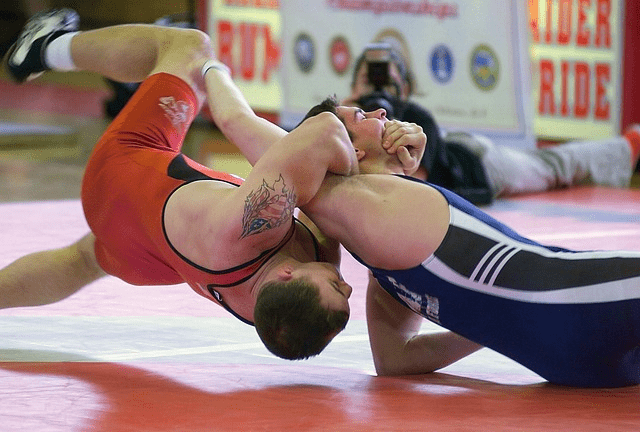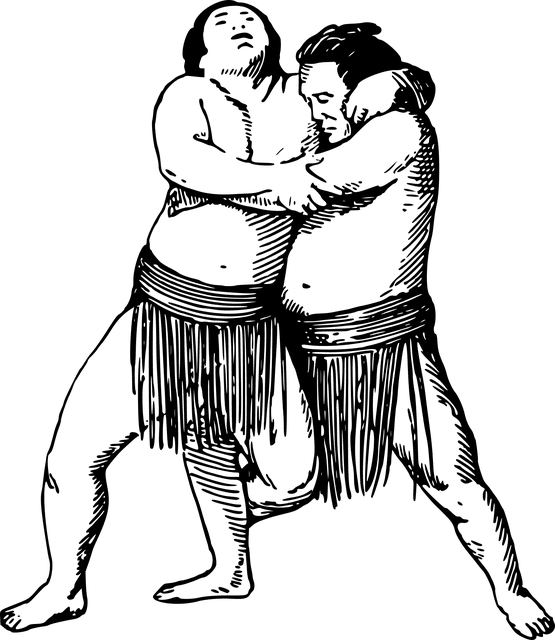Catch wrestling refers to the classical grappling style with modified rules or a combat sport, which is different thanks to traveling funfair wrestlers who discovered and developed their submission holds, also known under the name “hooks”.

There are so many catch wrestling forms all around the world.
Why Is It Called Catch Wrestling?
The name catch wrestling appeared because there are fewer limits in catching and holding compared to, for example, Greco-Roman and freestyle wrestling. Many more submissions and holds are allowed, and catch wrestlers can hurt their foes with so many various techniques. For example, any MMA matches are finished via catch wrestling techniques.
Many dangerous techniques were banned when the sport joined the Olympic family back in 1904. Later amateur catch wrestling was recognized as “freestyle wrestling”. It was separated from dangerous catch style.
Rules And Requirements
The ultimate goal of catch wrestling is to defeat your opponent by pinning him to the mat (his both shoulder blades or any part of the shoulders should remain on the ground) while not going for a submission attempt (in that case, you cannot win the bout).
You can also defeat the opponent via submission in a catch wrestling fight (force him to surrender by causing pain via legitimate technique in a controlled way).
As soon as the opponent taps or the referee confirms that the pin has happened, catch wrestlers must release the hold right off the bat. Breaking these rules leads to an instant disqualification for the catch wrestler.
You are not allowed to eye gouge, bite, kick, fish hook, or hair grab your opponent. Individual finger locks are illegal (no toe hold), alongside full nelson and clothes grabbing. Talking during the catch wrestling combat is one of the greatest fouls, and it can lead to a disqualification too.
WHAT IS ACCEPTABLE
Here is the list of legal techniques in a catch wrestling combat (even Brazilian jiu jitsu isn’t that liberal, this could work well in an MMA tournament too):
- Ankle lock;
- Knee lock;
- Hip lock;
- Spine lock;
- Neck lock;
- Shoulder lock;
- Elbow lock;
- Wrist lock;
- Hand lock;
- Indirect choke / strangle – for example – an inside arm, front face lock (grovit) is allowed.
Many notable MMA fighters (for example, Josh Barnett) come from catch wrestling backgrounds for a reason – catch as catch can offer so many different ways to finish your rival legally! Josh Barnett might be the most famous western catch wrestler in mixed martial arts thanks to his outstanding successes in Pride FC and other high-level promotions.
There are so many tremendous leg locks in this fighting discipline too.
MATCHES
The pre-match catch wrestling requirements include the following:
- A wrestler must take part in weight checks at 6 PM one day before the fight.
- The wrestler’s skin must be dry of grease, and oil, and it has to be substance free.
- Catch wrestlers must ensure that they disclose any contagious condition such as ringworm.
- The wrestler’s nails must be short.
- The official team does the checks.
- Catch as catch can fighters must wear the appropriate attire.
TIME SCALES
Catch wrestling competitors must be ready for the competition. Once their name is called they have one minute to appear on the mats, failing to do so will lead to instant disqualification.
NOTIFICATION OF MATCHES
The pairing table will provide you with all the info – your fight number, the name of your opponent, and the potential time.
LENGTH OF MATCHES
There were no time scales in catch wrestling combats throughout history, as matches lasted until one fighter was unable to continue until one of the catch wrestlers wins via pin or a submission. But time restrictions appeared as the sport evolved.
You will get all the rules on the tournament invitation letter, the evening schedule is planned. Yet, there is no break or rest period once the catch wrestling match commences. The ref can only call an injury time-out, but you are not allowed to ingest fluid or water during the combat.
Most matches are contested as the best two or three falls, with a maximum length of an hour. If there is no pin or submission, the ref will decide the combat winner, depending on who was more dominant catch as catch can wrestler throughout the combat.
INJURY TIME
The referee or the medic has the right to call for an injury time when it’s required. Sometimes the bout could lead to the termination of the catch wrestling battle, especially in the case of excessive bleeding that can’t be stopped within a reasonable timescale.
There is no strict time for a medical timeout, but a medic has the right to prevent an athlete from continuing combat submission wrestling if he believes he’s endangered.
SAFE ZONE RULES
Catch wrestling matches will take part on approved, safe mats. When the wrestler in catch wrestling contests leaves the fighting area during the combat in the disadvantage position, the ref gets both fighters to the center of the mat to the previous position before the foul.
When nobody was in the dominant position before the fighters left the mat, the referee will restart the bout in the center from the standing position.
How Do You Win In Catch Wrestling?

The best way to win a catch wrestling combat is via submission or a pin. Yet, a chokehold is barred often too. In those cases, there is absolutely no doubt who won the catch wrestling combat.
In other cases, there are matches contested as the best two of three falls. When there is no winner after an hour (or shorter, depending on the tournament rule set), the referee will determine the dominant wrestler and give him a win due to superiority.
What Is The Difference Between Wrestling And Catch Wrestling?
Classic wrestling is more about dominant positions and point domination. Catch wrestling is the parent style of both freestyle wrestling and professional wrestling, it is present in earlier folk styles.
For example, Greco-Roman limits grabbing under the waist, while in freestyle you can use all kinds of techniques to trap your opponent and pin him to the canvas. In catch wrestling, you’ll rarely see the fight going the distance, as your ultimate goal is pinning or submitting the opponent.
But catch wrestling also adds a Brazilian jiu jitsu aspect, as you are allowed tons of submissions and finishes. Unlike in Judo competitions, the majority of leg locks and joint manipulations are perfectly legal. Catch wrestling moves are awesome for mixed martial arts combat too!
There’s way more grappling game and freedom to force your opponent to tap out. A good catch wrestler might have an equal or even better submission game compared to BJJ practitioners!
Catch-as-catch-can Meaning
According to the Oxford dictionary, catch-as-catch-can (archaic syntax) refers to “wrestling where all kinds of holds are allowed”. According to the Merriam-Webster dictionary, it symbolizes “using any available means or method”.
Origin Of Catch-as-catch-can
This sport was developed by J.G. Chambers in Great Britain in 1870. Catch wrestling was derived from many different forms of wrestling – a few versions of English wrestling styles – Lancashire, Cumberland, Westmoreland, and popular Irish collar-and-elbow style).
Professional wrestling used to be a competitive catch wrestling, and the historical World Heavyweight Wrestling Championship occurred in 1905 to discover the best catch wrestling guy in the world. The belt was retired in 1957.
Modern-day professional wrestling has some similarities with ancient catch wrestling, but aerial stunts and acrobatics, alongside striking, were turned into a spectacle to keep the crowd entertained.
Catch As Catch Can Wrestling Techniques
There are so many techniques available for a great catch wrestler, but we will focus on the six basic areas of the sport. Here they are:
- Takedowns – a very important part of the game since day one, you can trip the opponent in professional wrestling in any way possible.
- Leg locks – catch wrestling has always been ahead of BJJ for its leg lock arsenal, as only new-era BJJ fighters are famous for their leg manipulations.
- Arm locks – these kinds of manipulations are often by grapplers in mixed martial arts too – hammer lock, shoulder lock, or wrist lock also fall under this category. Just to remind you, a double wrist lock is perfectly legal here.
- Kneebar – the knee is pushed into hyperextension, this technique appeared in catch wrestling in the first place, then it became the trademark of Sambo.
- Chest locks – the chest lock involves the use of the arm and shoulder, wrapped around an opponent’s head from the hind, with the hips facing their head to hold them in that position. You can see this type of finish only in catch wrestling and mixed martial arts, not other grappling styles.
- Neck cranks – the jiu jitsu guy will let go when the arm is not under the neck, but neck cranks are also the trademark of catch wrestling as they perform tons of painful manipulations on the neck since day one of their training.
Catch Wrestling Vs Freestyle
The freestyle wrestling method prevalent offers a lot of liberality compared to, for example, the Greco-Roman style. You can hold under the belt and trip your opponent in any way possible, just like catch wrestling.
But freestyle wrestling combat uses legs for manipulations, trips, and takedowns, there is a lack of submission game compared to catch wrestling. Freestyle fighters mostly roll and use the legs to get into the dominant position, while catch as catch can bois tend to submit the leg.
The dominant position or high throw amplitude matters in a freestyle combat submission wrestling bout, but in a catch bout, points aren’t important at all as bouts very often finish inside the distance and your ultimate goal is to finish your foe.
Difference Between Catch Wrestling And Brazilian Jiu Jitsu
The greatest difference is the lack of takedowns in Brazilian Jiu Jitsu. When a BJJ fighter enters mixed martial arts matches, he’s mostly having a hard time dragging the fight to the ground, while a catch wrestler is very skillful in dragging the combat to the canvas.
Gi submissions are another important difference. For example, you cannot perform bow and arrow choke in a no-gi wrestling combat. Neck cranks are very much rare in BJJ, but submission switches are interestingly more often in modern jiu jitsu.
What Is A Hook In Combat?
Hooks is a term in grappling martial arts which represents the careful positioning of your feet and leg to control and manipulate the movement of your foe. For example, there is a rear-naked choke with both hooks in (legs around the waist) or from a body triangle (legs wrapped around the opponent’s waist in figure four).
Hooks are a great way to not let the opponent slip out of your dominant position. A hook specialist doesn’t have to be super-powerful to control his opponent on the canvas – and catch wrestling rolling is based on the excessive use of hooks!
What Is Japanese Wrestling Called?

Japanese professional wrestling is called “puroresu”. You will lose the combat when you’re out of the ring or when any part of your body (not feet) touch the ground. It’s Japan’s martial art.
But Japanese professional wrestlers also compete in shoot wrestling, where you have pretty much similar rules to normal catch wrestling. Many shoot wrestling fighters show great results in the mixed martial arts boom thanks to their great knowledge and understanding of submissions, especially leg manipulations.
If you love squared rings, please watch Shinja Aoki, you’ll see what am I talking about.
Catch Wrestlers
There are catch wrestlers from nine states of the world at the moment – America, Belgium, Brazil, Bulgaria, Canada, Great Britain, Estonia, Iran, and Japan.
Japanese fighters with a catch background are the most famous in MMA. But other famous names from different states include Jose Aldo, Eddie Alvarez, Demetrious Johnson, Ken Shamrock, Frank Trigg, and others.
Main Catch Wrestling Tournaments
Catch Wrestling Association, also known under the nickname of German professional wrestling promotion, hosts many catch wrestling tournaments, but the most famous ones are:
- CWA British Commonwealth Championship;
- CWA Intercontinental Heavyweight Championship;
- CWA Submission Shootfighting Championship;
- CWA World Heavyweight Championship;
- CWA World Junior Heavyweight Championship;
- CWA World Middleweight Championship;
- CWA World Tag Team Championship;
- German Heavyweight Championship.


